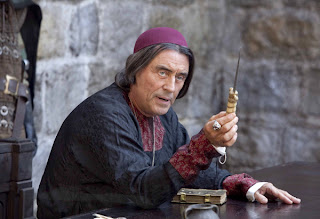 |
| An engraving by A. Van Assen, 1804 |
Patrick Cotter O’Brien (1760-1806) was at one time the tallest man in the world, reported to stand anywhere from 8′ 1″ to 8′ 6″ tall. Patrick Cotter was born at Kinsale, County Cork in either the year 1760 or 1761. When he was a teenager, a travelling showman discovered him working as a bricklayer and brought him to England to star in his ‘freak of nature’ show. He added the stage name ‘O’Brien’ to his own to connect himself with the legendary Celtic giants. The showman who’d discovered Patrick and paid him fiftypounds per annum also obtained the right to exhibit him for three years in England. Details become sketchy, but it appears as if the showman then attempted to sublet the right to show Patrick to another and Patrick objected. The showman then charged Patrick with a fictitous debt and he was thrown into a sponging house in Bristol. Soon after, a visitor to the Sheriff, a man of means, met Patrick, heard his tale and succeeded in having him freed from jail and, more importantly, from any obligation he might have had to the showman – shades of Dickens!
At this time, Patrick was 18 years of age and, again with the help of his benefactor, he was able to set himself up in the fair then held in St. James’s, London where, in three days time, he earned thirty pounds. Patrick made his first public appearance at the Full Moon tavern in Stokes Croft, Bristol on the 19th July 1783; and indeed it appears that he made his home at Bristol whilst travelling around the country appearing at various theatres and fairs. In 1785 it was advertised that he was again to be ‘seen by the quality’ in a room in James Street, London for the sum of two shillings. In the same year, he appeared at the Sadler’s Wells theatre in a bill shared with some performing animals and fourteen years later he was still turning a profit whilst appearing in a booth at the Bartholomew Fair. His career certainly extended over twenty years until 1804 when he decided he had made enough money to retire to Clifton in Bristol.
Patrick had himself a special coach made, with a lowered floor that included a box for his feet. Once, when held up by a highwayman, Patrick had only to pull back the curtain and look out the window in order to send his would be robber terrified into the night. It was said that Patrick’s height allowed him to walk down the street and light his cigars on the streetlamps.
The remainder of Patrick’s life was spent in Bristol and he is there still referred to as the ‘Bristol Giant’. When he died in 1806, he instructed that his body be protected from bodysnatchers and the knives of curious surgeons. His coffin, therefore, born by 14 pallbearers, was lowered into a vault cut 12 feet deep into solid rock and heavy iron bars were cemented into the walls. Patrick left his clothing to a servant, who dressed up a huge figure in resemblance of his master in the clothes and exhibited them throughout London. His considerable earnings Patrick left to his mother. His giant boots are on diplay at the Bristol Museum and, this past summer, one of his super-sized gloves was at the centre of an eccentric exhibition at the Head of Steam museum in Darlington.
O’Brien’s remains were exhumed in 1972 and surgeons determined that he would have stood 8′ 1″ tall, making him one of only 12 men in medical history to be verified as having stood over eight feet tall.


























